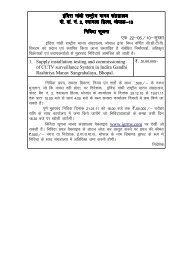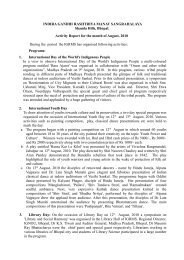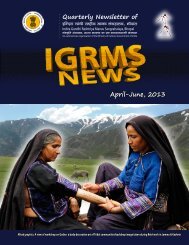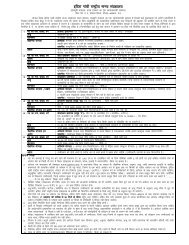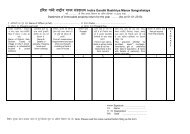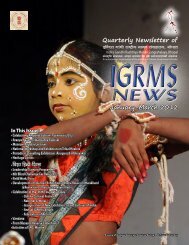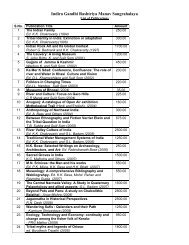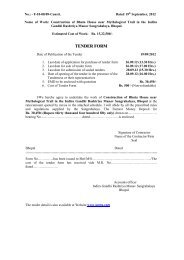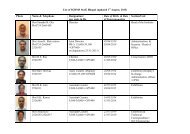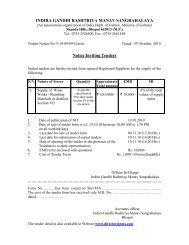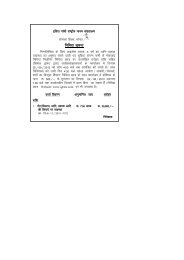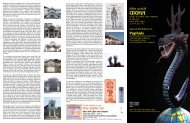Indira Gandhi Rashtriya Manav Sangrahalaya (National ... - IGRMS
Indira Gandhi Rashtriya Manav Sangrahalaya (National ... - IGRMS
Indira Gandhi Rashtriya Manav Sangrahalaya (National ... - IGRMS
You also want an ePaper? Increase the reach of your titles
YUMPU automatically turns print PDFs into web optimized ePapers that Google loves.
282 Multiple Heritage: Role of Specialised Museums in India<br />
Tribal Habitat was the first open air exhibition complex designed to be<br />
developed on the south-eastern hill top of the campus. Unique dwelling types of<br />
architectural marvels from different tribal communities were selected to represent<br />
from the Gangetic plains of Uttaranchal, lush green forest areas of North-east<br />
India, the arid region of western India, plateau region of central India, hilly tracts<br />
of eastern India, the Nilgiri (blue-mountain) tracts of south western India etc.<br />
The initial set of about ten habitats were re-erected, and the Exhibition was opened<br />
for public in January, 1988. Presently, there are over thirty house-types, youth<br />
dormitories, shrines and other centres of cultural interactions clustered together<br />
in this section . These dwellings represent the Warli community of Maharashtra,<br />
Kutia Kondh, Saora and Gadaba communities of Orissa, Rathwa and Chodhri<br />
tribes of Gujarat, Boda Kachari, Mishing and Karbi tribes of Assam, Agaria and<br />
Bhil communities of Madhya Pradesh, Kars and Rajwars of Chhattisgarh, Santal<br />
tribe of Jharkhand, Jatapu tribe of Andhra Pradesh, Bhumij from West Bengal,<br />
Tangkul and Kabui Nagas from Manipur, Chakhesang Naga of Nagaland, Reang<br />
tribe of Tripura, Toda and Kota communities of Tamilnadu. The most striking<br />
feature of this Exhibition is that the exhibits are life-size dwellings built by the<br />
different tribal communities themselves, based on their traditional ground plans<br />
and architectural patterns. The materials which are traditionally used for<br />
construction in their respective regions, were specially transported to Bhopal for<br />
creating the replica. Select groups of tribal artisans were invited to Bhopal to reconstruct<br />
their dwellings and create a genuine ambiance within and outside their<br />
dwellings. To create the ambiance, the concerned tribal groups did their own<br />
home-work by surveying their regional hamlets to understand the intriguing<br />
patterns of structural designs, placement of house-hold objects in each locations<br />
within and outside the house, collect the sacred plants ritualistic objects to be<br />
planted outside the house-types. The community groups came to <strong>IGRMS</strong><br />
representing different categories of performers i.e. brick makers, carpentry<br />
technicians and even priests to sanctify their house-types. They act as ambassadors<br />
of their community groups. Once the house is re-erected, they would explain to<br />
the Museum staff how to document the myths and legends of their community<br />
origin, the different ritual forms, the importance of space distribution, and their<br />
culinary traditions. They would teach the museum staff their traditional ways of<br />
structural conservation and other feed-backs for maintenance and upkeep. In a<br />
way they take over the role of curators of the exhibits, and the museum personnel<br />
were trained how to explain their customs and traditions to the visitors. From<br />
time to time they would visit the campus to oversee the arrangements in each of<br />
their house-types. The museum staff would also visit the hamlets of these tribal<br />
groups, document their festivities and craft traditions, to display these elements<br />
in the house-types.<br />
Today, ‘Tribal Habitat’ is one of the important exhibition premises, spread<br />
over in about forty acres of land, which attracts a large number of visitors to the



